Wai-Fah Chen.The Civil Engineering Handbook
Подождите немного. Документ загружается.

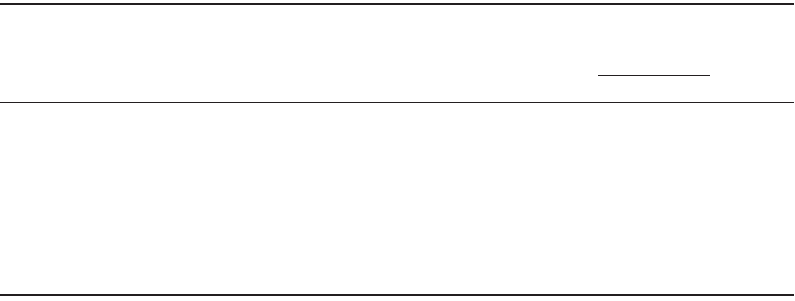
29-30 The Civil Engineering Handbook, Second Edition
TA BLE 29.7 Physical Properties of Common Gases at Standard Sea-level Atmosphere and 68°F in English Units
Liquid
Chemical
Formula
Molecular
We ig ht
Specific
We ig ht,
g,
lb/ft
3
Viscosity
m ¥ 10
7
,
lb·s/ft
2
Gas Constant
R,
ft·lb/(slug·°R)
[= ft
2
/(s
2
·°R)]
Specific Heat,
ft·lb/(slug·°R)
[= ft
2
/(s
2
·°R)]
Specific
Heat
Ratio
k = c
p
/c
u
c
p
c
u
Air 29.0 0.0753 3.76 1715 6000 4285 1.40
Carbon dioxide CO
2
44.0 0.114 3.10 1123 5132 4009 1.28
Carbon monoxide CO 28.0 0.0726 3.80 1778 6218 4440 1.40
Helium He 4.00 0.0104 4.11 12,420 31,230 18,810 1.66
Hydrogen H
2
2.02 0.00522 1.89 24,680 86,390 61,710 1.40
Methane CH
4
16.0 0.0416 2.80 3100 13,400 10,300 1.30
Nitrogen N
2
28.0 0.0728 3.68 1773 6210 4437 1.40
Oxygen O
2
32.0 0.0830 4.18 1554 5437 3883 1.40
Water v a p or H
2
O 18.0 0.0467 2.12 2760 11,110 8350 1.33
From Daugherty, R.L., Franzini, J.B., and Finnemore, E.J. (1985) Fluid Mechanics with Engineering Applications, 8th ed.,
McGraw-Hill, New York. With permission.
© 2003 by CRC Press LLC
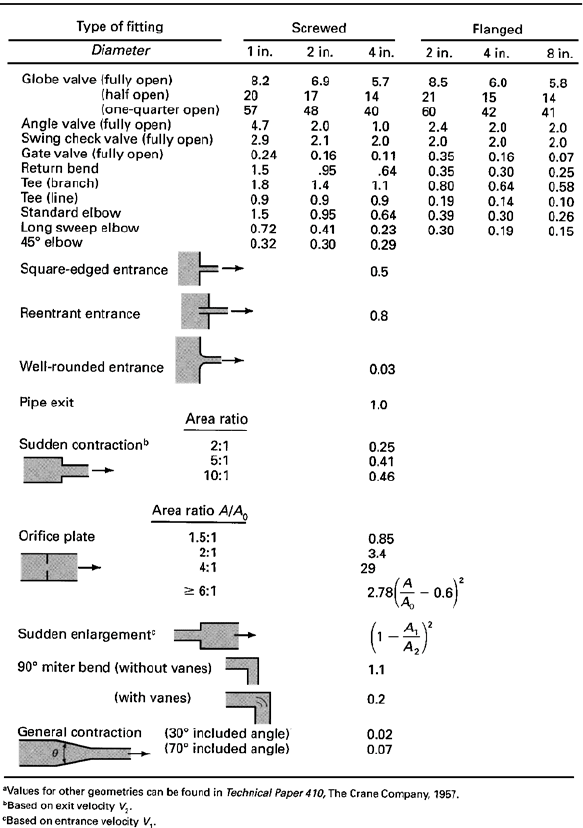
Fundamentals of Hydraulics 29-31
TA BLE 29.8 Nominal Minor Loss Coefficients K
m
(turbulent flow)
a
Adapted from Potter, M.C. and Wiggert, D.C. (1997). Mechanics of Fluids, 2nd ed., Prentice-Hall,
Englewood Cliffs, NJ.
© 2003 by CRC Press LLC
29-32 The Civil Engineering Handbook, Second Edition
References
Bos, M.G. (ed.,) (1989) Discharge Measurement Structures, 3rd ed., publication 20, International Institute
Land Reclamation and Improvement, Wageningen, The Netherlands.
Miller, R.W. (1989) Flow Measurement Engineering, 2nd ed., McGraw-Hill, New York.
Sharpe, J.J. (1981) Hydraulic Modelling, Butterworths, London.
Yalin, M.S. (1971) Theory of Hydraulic Models, MacMillan, London.
Further Information
Most of the topics treated are discussed in greater detail in standard elementary texts on fluid mechanics
or hydraulics, including:
Crowe, C.T., Roberson, J.A., and Elger, D.F. (2000) Engineering Fluid Mechanics, 7th ed., John Wiley &
Sons, New York.
Daugherty, R.L., Franzini, J.B., and Finnemore, E.J. (1985) Fluid Mechanics with Engineering Applications,
8th ed., McGraw-Hill, New York.
Fox, R.W. and McDonald, A.T. (1998) Introduction to Fluid Mechanics, 5th ed., John Wiley & Sons, New
Yo r k .
Gray, D.D. (2000) A First Course in Fluid Mechanics for Civil Engineers, Wa ter Resources Publications.
Potter, M.C. and Wiggert, D.C. (1997) Mechanics of Fluids, 2nd ed., Prentice-Hall, Englewood Cliffs, NJ.
© 2003 by CRC Press LLC

© 2003 by CRC Press LLC
30
Open Channel
Hydraulics
30.1 Definitions and Principles
Classification of Flows • Flow Regimes
30.2 Balance and Conservation Principles
Conservation of Mass • Conservation of Momentum •
Piezometric Head • Boundary Shear • Total Thrust and Specific
Force • Balance of Mechanical Energy • Specific Energy •
Hydraulic Jump
30.3 Uniform Flow
30.4 Composite Cross-Sections
30.5 Gradually Varied Flow
30.6 Water Surface Profile Analysis
The Mild Slope Profiles • The Steep Slope Profiles • The Critical
Slope Profiles • The Horizontal Slope Profiles • The Adverse
Slope Profiles
30.7 Qualitative Solution of Flow Profiles
Phase I — Determination of Critical Depths and Normal
Depths • Phase II — Virtual Control Section (VCS)
Determination • Phase III — Profile Sketching
30.8 Methods of Calculation of Flow Profiles
30.9 Unsteady Flows
30.10 Software
Open channel hydraulics, a subject of great importance to civil engineers, deals with flows having a free
surface in channels constructed for water supply, irrigation, drainage, and hydroelectric power generation;
in sewers, culverts, and tunnels flowing partially full; and in natural streams and rivers. Open channel
hydraulics includes steady flows that are unchanging in time, varied flows that have changes in depth and
velocity along the channel, and transient flows that are time dependent. This chapter deals only with rigid-
boundary channels without sediment deposition or erosion. In addition, this chapter assumes that wind
and surface tension stresses exerted on the free surface are negligible, and that velocities are low enough
that air is not entrained. The emphasis is on the one-dimensional treatment of uniform and nonuniform
flows which are common in civil engineering practice. Design aspects of structures involving free surface
flows are discussed in Chapter 35. Sediment transport in open channels is covered in Chapter 33.
30.1 Definitions and Principles
Open channel flow
is the flow of a single phase liquid with a free surface in a gravitational field when the
effects of surface tension and of the overlying gas can be neglected. Because laminar open channel flows
Aldo Giorgini
(deceased)
Donald D. Gray
West Virginia University
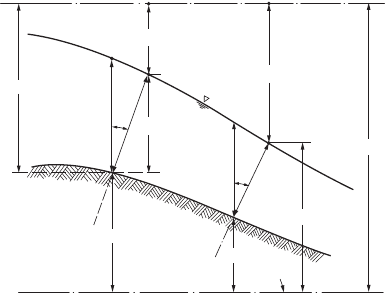
30
-2
The Civil Engineering Handbook, Second Edition
are seldom encountered in civil engineering practice, only turbulent flows will be considered in this
chapter. The analysis of open channel flows is largely based on the approximation that the mean stream-
lines are nearly parallel. As shown below, this implies that the piezometric head is nearly constant on
planes normal to the flow, and allows a one-dimensional analysis. Regions of nonparallel streamlines are
considered by using control volume arguments. In some cases, these assumptions are inadequate, and a
much more complicated two- or three-dimensional analysis must be used.
For any given cross section, the following terminology and notation are used:
•The region of the cross section occupied by the liquid is called the
flow area
,
A
.
•The part of the cross section perimeter which is below the water surface is called the
wetted
perimeter
,
P
.
•The length of the free surface is called the
top width
,
T
. This is normally assumed to be horizontal.
•The hydraulic depth is
D
=
A
/
T
.
•The hydraulic radius is
R
=
A
/
P
.
•The
water surface elevation, h
, is the vertical distance of the free surface above a reference elevation
or datum. In Fig. 30.1,
h
is the water surface elevation at cross section 2.
•The
invert
is the lowest point of the cross section.
•The vertical distance to the free surface from the lowest point of the cross section is called the
depth of flow,
y
, or
depth
. Referring to Fig. 30.1,
y
1
is the depth corresponding to the invert at point A.
•The perpendicular distance from the invert to the free surface is called the
thickness of the stream
,
d
. Referring to Fig. 30.1,
d
1
is the thickness of the stream at cross section 1. If the free surface is
nearly parallel to the bottom of the channel,
d
=
y cos
q
, where
q
is the angle between the bottom
of the channel and the horizontal. For the small slopes normally encountered in rivers and canals
d
y
. The pressure head on the channel bottom is
y cos
2
q
=
d cos
q
.
For
q
< 5° the error in
approximating the pressure head by
y
is less than 1%.
•The width of a rectangular channel is its
breadth
,
b
.
Special importance attaches to
prismatic channels
: those that have a constant cross sectional shape,
longitudinal slope, and alignment. The generators of prismatic channels are parallel straight lines. The
most common prismatic channel cross sections are trapezoids, rectangles, and partially full circles.
Constructed channels often consist of long prismatic reaches connected by short transition sections.
Natural channels are never prismatic, although the assumption that they are is sometimes tolerable.
The direction of flow is indicated by the spatial variable
x
; the two coordinates orthogonal to each
other and to
x
are called
y
¢
and
z
¢
. For a parallel flow, the total volume of water flowing per unit time
across an orthogonal flow area, is the
flowrate
or
discharge
,
Q
, given by
FIGURE
30.1
Definitions:
y
, depth of stream;
d
, thickness of stream; z, bottom elevation;
q
, angle between channel
bottom and horizontal;
E,
specific energy;
h,
piezometric head and water surface elevation;
H,
total head;
a
V
2
/2
g
,
velocity head. Subscripts denote flow area.
E
1
2
1
A
z = 0
datum
y
2
y
1
z
2
z
1
d
2
d
1
C
B
D
/2g
α
1
v
1
2
cosq
1
d
1
/2g
α
2
v
2
2
H
h
q
2
q
1
© 2003 by CRC Press LLC

Open Channel Hydraulics
30
-3
(30.1)
where
v
(
x, y
¢
, z
¢
,t
) is the local
x
-velocity at coordinates
x, y
¢
, z
¢
and time
t
.
The integral extends across the whole flow area, and
V
is the
mean velocity
.
Classification of Flows
Steady flows
are time invariant and
unsteady flows
are time dependent. Because open channel flows are
typically turbulent, and thus inherently unsteady in detail, these terms are understood to apply to the
time-averaged components of the flow variables.
Uniform
or
normal flow
is the important special case
of constant thickness flow in a prismatic channel. More common is
gradually varied flow
in which
streamwise changes in the flow area are sufficiently gradual that the time-averaged streamlines can be
assumed parallel. When the deviation of the time-averaged streamlines from being parallel cannot be
neglected, the flow is termed
rapidly varied
. If the flowrate changes along the direction of flow (due to
addition or withdrawal of liquid) it is a
spatially varied flow
.
Flow Regimes
Since free surface flows are affected by gravitational, viscous, and surface tension forces, the relevant
dimensionless parameters are the Froude number, the Reynolds number, and the Weber number. The
most important of these is the Froude number,
Fr
=
V
/
c
where
c
, the celerity, is the velocity of propagation
of a small amplitude, shallow water gravity wave. For an arbitrary cross section
c = (g D)
1/2
. For a
rectangular cross section this reduces to c = (g y)
1/2
. The Froude number compares the speed of the liquid
to the speed at which small disturbances of the free surface propagate relative to the liquid. When Fr < 1,
small disturbances can propagate upstream as well as downstream, and the flow regime is called subcritical,
tranquil, or streaming. When Fr > 1, small disturbances are too slow to propagate upstream. This regime
is called supercritical, rapid, or shooting. This distinction is of great practical importance because if the
flow at a given cross section is supercritical, downstream events cannot influence the flow unless they
are large enough to force the flow to change to subcritical. The rare case of Fr = 1 is called critical flow.
The Froude number can also be interpreted as being proportional to the square root of the ratio of the
inertial forces to the gravitational forces. Some authors define the Froude number as the square of the
present definition.
The Reynolds number may be defined for open channel flow as Re = 4reRV/m, where r is the mass
density and m is the dynamic viscosity of the liquid. (Many authors omit the factor of 4.) The Reynolds
number is proportional to the ratio of inertial forces to viscous forces. For Re < 2000, open channel flow
is laminar. When Re exceeds about 8000, it is turbulent. At intermediate values the flow is transitional.
In hydraulic engineering practice, laminar and transitional flows are rare, occurring mostly in shallow
sheet storm runoff from roofs and pavements.
The Weber number for open channel flow is defined as We = reDV
2
/s, where s is the surface tension
coefficient. The Weber number is a measure of the ratio of inertial forces to surface tension forces.
Although threshold values have not been determined, the high values typical of hydraulic engineering
applications indicate that surface tension effects may be neglected.
30.2 Balance and Conservation Principles
As shown in Chapter 28, the fundamental principles of nature may be written in a balance form for an
arbitrarily specified region called a control volume. In this chapter we consider a control volume which
contains all of the liquid between an upstream flow area (A
1
) and a downstream flow area (A
2
). The
lateral boundaries coincide with the wetted channel lining and the free surface.
Qxt vxy z tdydz V x t A x t
A
,(,,,) ,,
()
=
¢¢ ¢¢
=
()()
ÚÚ
© 2003 by CRC Press LLC

30-4 The Civil Engineering Handbook, Second Edition
Conservation of Mass
The principle of conservation of mass states that the time rate of change of mass inside a control volume
is equal to the balance between the inflowing and outflowing mass through the control surfaces. For
liquids of constant density, conservation of mass implies conservation of volume. In the case of steady
flow in a control volume which contains all of the liquid between an upstream flow area and a downstream
flow area, we have Q
in
= Q
out
= Q or
(30.2)
This is known as the continuity equation. For a rectangular channel of constant breadth
(30.3)
where q = Q/b is the specific flowrate or flowrate per unit breadth.
Conservation of Momentum
The principle of conservation of momentum states that the time rate of change of the momentum inside
a control volume is equal to the sum of all the forces acting on the control volume plus the difference
between the incoming and outgoing momentum flowrates. Note that it is a vector equation. For steady
flow with constant density along a straight channel, the streamwise component of the momentum
equation for a control volume that contains all of the liquid between an upstream flow area and a
downstream flow area becomes
(30.4)
where SF ¢ is the sum of the streamwise forces on the control volume.
These forces typically include the hydrostatic pressure forces on the flow areas, the streamwise com-
ponent of the weight of liquid within the control volume, and the streamwise force exerted by the wetted
surface of the channel. b is called the momentum correction factor and accounts for the fact that the
velocity is not constant across the flow areas:
(30.5)
The value of b is 1.0 for a flat velocity profile, but its value increases as the irregularity of the velocity
distribution increases.
Piezometric Head
As a first application of the momentum equation, consider the control volume shown in Fig. 30.2 having
sides AB and DC of length Dx parallel to the streamlines, sides AD and BC of length Dy ¢, and breadth
Dz¢ normal to the page. Since the momentum fluxes and shears along the faces AB and DC have no
normal component, the net pressure force in the y¢-direction (∂p/∂y¢) Dy ¢D xDz¢, must be balanced by
the normal component of the weight of the liquid in the control volume r gDxDy ¢Dz¢cosq =
r gDxDy¢Dz¢(∂z/∂y¢), thus ∂/∂y¢[z + p/(r g)] = 0.
Integration gives
(30.6)
where g =r g is the specific weight of the liquid
h =the elevation of the free surface
QAV AV==
11 2 2
q
Vd V d
==
11 2 2
¢
=-
()
Â
FQVVrb b
22 11
b=
Ú
1
2
2
VA
vdA
A
z
p
h+=
g
© 2003 by CRC Press LLC
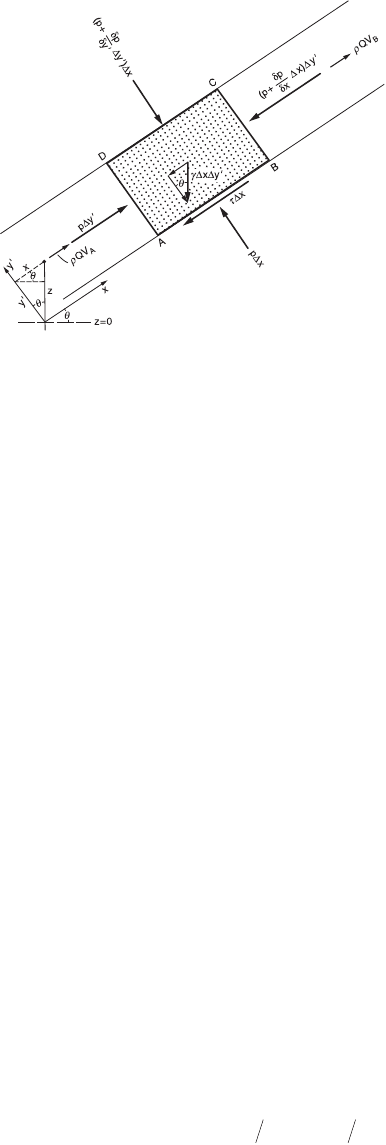
Open Channel Hydraulics 30-5
The sum of the elevation head and the pressure head, called the piezometric head, has the same value
at all the points of the same cross section of a parallel flow. This value is the elevation of the free surface
for that cross section. This result is of fundamental importance for open channel hydraulics and suggests
two corollaries: the pressure distribution within a given cross section of a parallel flow is hydrostatic, and
the free surface profile of a parallel flow may be defined as its piezometric head line or hydraulic grade line.
Boundary Shear
Apply the streamwise momentum Eq. (30.4) to a control volume that contains all of the liquid contained
between an upstream flow area and a downstream flow area in a prismatic channel. For uniform flow
the momentum flowrates and the pressure forces on the entry and exit faces of the control volume cancel.
Therefore the streamwise component of the weight of the fluid in the control volume must be balanced
by the shear force acting on the wetted perimeter. Thus, if t is the average shear stress on the channel
lining, g A Dx sinq = t PDx, or
t = g R sinq = g R S (30.7)
where S = sinq is the bottom slope of the channel.
Because the flow is uniform, S is also the slope of the piezometric head line and the total head line.
When Eq. (30.7) is applied to gradually varied flow, S is interpreted as the slope of the total head line
and is usually called the friction slope.
Total Thrust and Specific Force
Consider a control volume containing all of the liquid between upstream flow area A
1
and downstream
flow area A
2
in a prismatic channel. In this case the flow depth may vary in the streamwise direction.
The forces in the streamwise momentum Eq. (30.4) are the hydrostatic forces on the end surfaces and
the component of the weight of the liquid in the flow direction. Friction forces are neglected. The
momentum equation in the flow direction is thus
(30.8)
where d
1
represents the vertical depth of the centroid of flow area A
1
below the free surface of A
1
, and
W is the weight of the liquid in the control volume.
FIGURE 30.2 Forces and momentum flowrate on a fluid element.
gd gd q b r b r
11 2 2 2
2
21
2
1
AAW QAQA-+ = -sin
© 2003 by CRC Press LLC
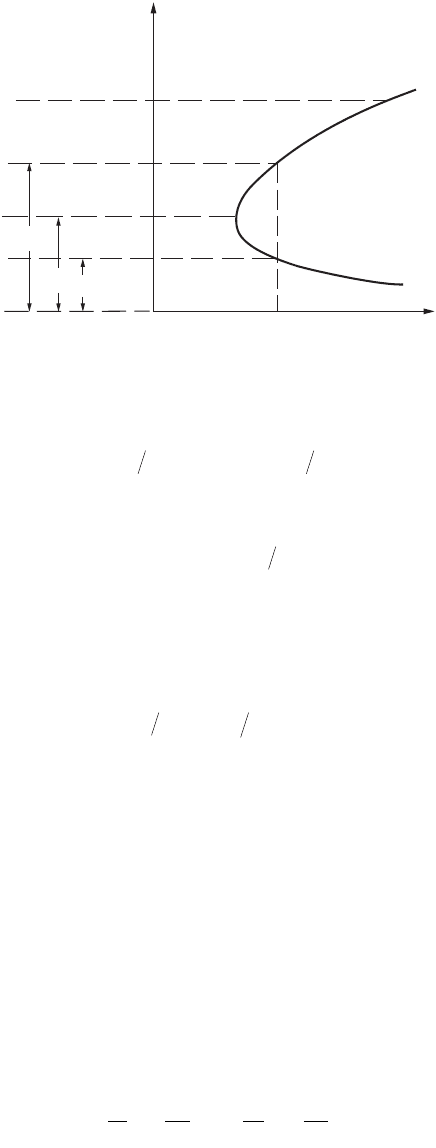
30-6 The Civil Engineering Handbook, Second Edition
This can be rearranged as
(30.9)
where the expression in parentheses is called the total thrust, F.
(30.10)
The total thrust is the sum of the hydrostatic thrust gdA, which increases with flow thickness, and the
momentum flowrate brQ
2
/A, which decreases with flow thickness if Q and b are assumed constant.
Therefore the total thrust reaches a minimum at the critical stream thickness, d
c
, as illustrated in Fig. 30.3.
This value can be found by setting the derivative of F with respect to d equal to zero with the result that
(30.11)
For most cross sections, Eq. (30.11) must be solved numerically. The function F/g is known variously
as the specific force, momentum function, or thrust function.
Balance of Mechanical Energy
The mechanical energy of a body of mass m is the sum of its gravitational potential energy mgz and of
its kinetic energy mv
2
/2, where z is the elevation of the mass m above a reference datum. The principle
of conservation of mechanical energy states that the time rate of change of the mechanical energy in a
control volume is equal to the net flowrate of mechanical energy at the inlet and outlet sections, plus
the work done by the pressure forces at the inlet and outlet sections, plus the loss of mechanical energy
in the control region. For the steady flow of an incompressible liquid through a control volume where
the flow is parallel and normal to a single plane inflow area and a single plane outflow area, the mechanical
energy equation in terms of head becomes
(30.12)
where h
L
is the head loss and a is the kinetic energy correction factor that accounts for the nonuniformity
of the velocity across the flow area.
FIGURE 30.3 Total thrust curve.
d
C
O
F
p
2
d
1
d
2
d
c
F
1
P
1
gd b r gd b r q
11 1
2
1222
2
2
AQA A QAW+
()
=+
()
- sin
FAQA=+gd br
2
AT Q g
d
c
32
()
=
()
bqcos
z
pV
g
z
pV
g
h
L1
1
1
1
2
2
2
2
2
2
22
++ =++ +
g
a
g
a
© 2003 by CRC Press LLC

Open Channel Hydraulics 30-7
(30.13)
The value of a is 1.0 for a flat velocity profile, but increases as the velocity profile becomes more
irregular.
The total head H is defined as the sum of the elevation head, pressure head, and velocity head, or as
the sum of the piezometric head and the velocity head.
(30.14)
Therefore Eq. (30.12) states that the total head at cross section 1 exceeds that at cross section 2 by the
head loss between the sections. In terms of the variables shown in Fig. 30.1, Eq. (30.12) can be written as
(30.15)
Specific Energy
Bakhmeteff (1932) first emphasized the importance of the quantity E, where
(30.16)
which he called the specific energy. (Because of its dimensions, E is more properly called specific head.)
In terms of the specific energy, Eq. (30.12) becomes
(30.17)
which shows that the specific energy is conserved when h
L
= z
1
– z
2
, i.e., in uniform flow. It is this property
that gives the specific energy its importance.
Equations (30.16) and (30.17) are the foundations for the calculation of gradually varied water surface
profiles. Given Q, q, a
1
, d
1
, and the geometry of cross-section 1, E
1
can be evaluated using Eq. (30.16).
Then Eq. (30.17) can be solved for E
2
, if an estimate of the head losses h
L
is possible. Once E
2
is known,
Eq. (30.16) can be solved for d
2
.
Equation (30.16) shows that E is the sum of two terms. Assuming that a and Q are constant, the first
term increases and the second decreases as d increases. Hence there is a critical thickness, d
c
, for which E
is a minimum. By differentiating Eq. (30.16) with respect to d and equating the derivative to zero, the
following condition for critical flow is obtained.
(30.18)
The expression A
3
/T is called the section factor for critical flow. For most cross sections, Eq. (30.18)
must be solved numerically. Note that the critical depth is independent of the channel slope and rough-
ness. It is interesting to recognize that the critical thickness which satisfies Eq. (30.18) differs from that
which satisfies Eq. (30.11) unless a = b, which is true only for a flat velocity profile. In practice, the
difference is usually negligible; and Eq. (30.18) is used in the calculation. The velocity corresponding to
d
c
, called the critical velocity, V
c
, is given by
(30.19)
a=
Ú
1
3
3
VA
vdA
A
Hz
pV
g
h
V
g
=+ + =+
g
aa
22
22
zd V g zd Vgh
L11 1 11
2
22 2 22
2
22++
()
=+ +
()
+cos cosqa qa
Ed V g d Q gA=+
()
=+
()
cos cosqa qa
222
22
zE z Eh
L112 2
+=++
AT Q g
d
c
32
()
=
()
aqcos
Vg D
c
=
()
cosqa
12
© 2003 by CRC Press LLC
